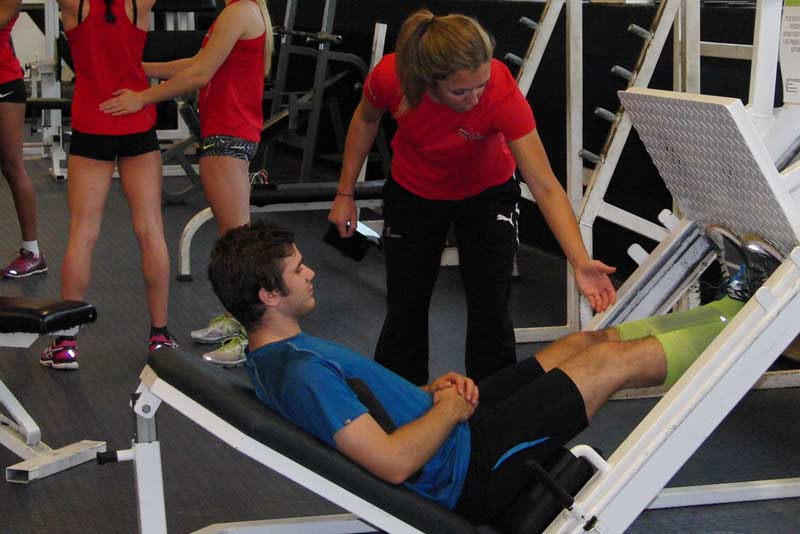ALTIS and Freelap — two of the biggest names in T&F — have come together to celebrate progress in our sport. We hope you enjoy this week’s blog-post. Share if you enjoy it!

By Ellie Spain
It’s universally acknowledged that words have power. Effective communication can fast-track an athlete’s learning. Equally important, it builds emotional connections, develops mutual trust, and maintains effective coach-athlete relationships.
The Communication Spectrum
When thinking about communication, many of us think of words alone. Consider the conclusions we make about people based on first impressions. Without realizing it, we scan their clothes and look at their posture and body language. We listen to their accent, the way they speak, and the volume at which they speak. We notice whether they make eye contact. What we see and what we hear mesh together and communicate meaning to us, and we often judge accordingly.
For those of us on the front lines in leadership roles, the ability to communicate effectively through a spectrum of methods–written, non-verbal, and verbal–is imperative. Having the skill to do so in real time without the convenient filters of computer screens and delete buttons is vital. When we interact with others, we cannot take back our words and actions. Time marches on, and the deed is done.
We’ve all listened to people who mesmerize us with their use of words regardless of their message. How do we become better communicators to maximize our impact when coaching, leading, or teaching? What is it that sets remarkable communicators apart from their less effective colleagues?
External Communication: How to Interact with Others
Accomplished Communicators are Minimalists
Effective communicators eliminate unnecessary padding from their message. Just as extraneous details in training schemes can reduce a program’s effectiveness, embellishing our ideas with unnecessary words dilutes the message. We are creatures of deletion and have limited retention capacity in our short term sensory store to hold information. Make sure your message doesn’t drown in your own noise.
Stop, Look, Listen, Observe
Is it a good time to speak?
Knowing what not to say and when not to say it is a hallmark of effective communicators. Likewise, being a diligent and interested listener is key to understanding others.
While listening to really great music, we’ll hear pauses. The pauses are as much a part of the melody as the notes. The same is true of effective speakers. The best orators speak at a pace to suit the message, vary the pitch of their voice, and pause in appropriate places. Don’t be afraid to count to five before answering a question or giving feedback. Silence can be powerful.
Provide Context
When giving instruction, our words have greater impact if we offer a framework of meaning to underpin the message. Make sure athletes understand why they’re doing something. Their buy-in will be far higher. As Victor Frankl said, “He who knows the ‘why’ for his existence, will be able to bear almost any ‘how’.”

Figure 1. Provide context with instruction. Athletes should understand the “why” behind the exercise.
It’s Not What You Said, It’s the Way You Said It
There is a gap between stimulus and response. The stimulus is what we say. The gap occurs when the listener takes cues from the verbal and non-verbal messages delivered and forms meaning from those cues. Mind that gap! Consider the words’ physical and emotional impact. Does the person bristle or relax? How does their face change? Great communicators are great observers.
Know the audience. Due to language and personal, cultural, or other reasons, everyone will interpret the same communication (particularly written and verbal) differently. We have to be conscious of their style and sensitivities. People interpret “what” and “how” differently.
Be Present
Communication is a two-way process. If an athlete is giving us feedback, and we are “listening” while simultaneously typing on the phone, tying our shoe, and sipping a Starbucks, they will not feel valued. Instead, look them in the eye and try to figure out what they’re saying.
Information is gold dust in coaching. Often the athlete is our best teacher, if we listen to them. As Steven Covey said, “Seek first to understand, then be understood.”
Information is gold dust in coaching. Often the athlete is our best teacher, if we listen to them. Click To TweetInternal Communication: The Inner Monologue
Know Thyself
“Know thyself” was inscribed on the forecourt of the Temple of Apollo at Delphi by seven sages of ancient Greece. What does it mean? To be honest with yourself. Translated to a coaching context, have the consciousness to evaluate your skill sets. Know what you know, know what you don’t know. Do something to plug those gaps.
Emotional Control
What presses our buttons? What makes us mad? Understand the stressors, whether they’re locations, people, or words. This allows us to internally control our response to situations. Otherwise we react and vocalize something we later regret. Learning to create helpful internal dialogue and process our thoughts before we externalize them becomes a huge asset for any coach. Especially in pressure situations when the temptation exists to verbally erupt.
Self-sabotage
Although the proverbial devil on our shoulder affects everyone, self-sabotage is a game changer for athletes. Self-talk and self-sabotage are huge factors in both coaching and athlete development. Regardless of the instructions we give or the inspired pep talks we deliver to bolster confidence, if an athlete is listening to their own faulty or negative internal dialogue, we’re fighting a battle with an invisible third enemy.
The Power of Agenda
Despite what we say, the impact of our communications will be limited if people:
- have a different agenda when we communicate with them
- have deep-rooted fears or insecurities about the topic being addressed
- do not have professional or personal respect for us
It’s critical to use communication wisely to build positive relationships and trust before we address difficult topics or offer well-intentioned feedback. No one likes to be told that their view is wrong or their status-quo or beliefs need to adjust. This is true for a technical model in the pole vault as well as a personal matter requiring emotional management.
Finally, as each day passes, people change, and situations change. No two communications will be exactly the same. Be responsive to shifting circumstances and environments.
“The past is a foreign country: they do things differently there.” L.P. Hartley, The Go-Between.
Please share so others may benefit.


Truly great info.